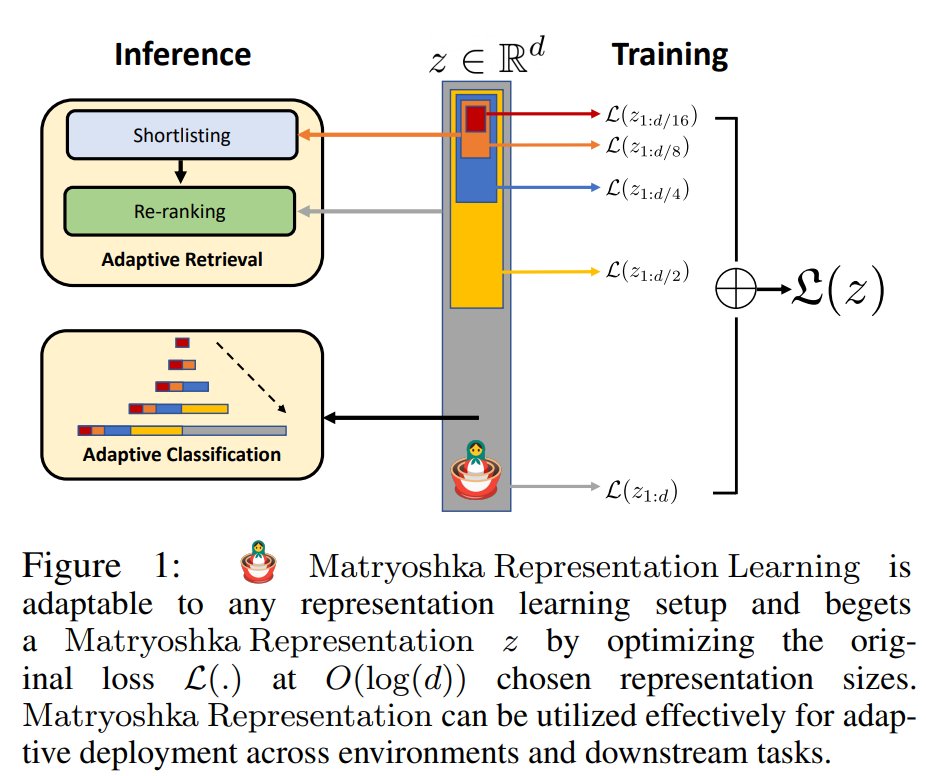Aditya Kusupati*, Gantavya Bhatt*, Aniket Rege*, Matthew Wallingford, Aditya Sinha, Vivek Ramanujan, William Howard-Snyder, Kaifeng Chen, Sham Kakade, Prateek Jain, Ali Farhadi
Learned representations are used in multiple downstream tasks like web-scale search & classification. However, they are flat & rigid -- Information is diffused across dimensions and cannot be adaptively deployed without large post-hoc overhead. We fix both of these issues with Matryoshka Representation Learning (MRL)🪆.
This repository contains code to train, evaluate, and analyze Matryoshka Representations with a ResNet50 backbone. The training pipeline utilizes efficient FFCV dataloaders modified for MRL. The repository is organized as follows:
- Set up
- Matryoshka Linear Layer
- Training ResNet50 Models
- Inference
- Model Analysis
- Retrieval
Pip install the requirements file in this directory. Note that a python3 distribution is required:
pip3 install -r requirements.txt
Following the ImageNet training pipeline of FFCV for ResNet50, generate the dataset with the following command (IMAGENET_DIR should point to a PyTorch style ImageNet dataset):
# Required environmental variables for the script:
cd train/
export IMAGENET_DIR=/path/to/pytorch/format/imagenet/directory/
export WRITE_DIR=/your/path/here/
# Serialize images with:
# - 500px side length maximum
# - 50% JPEG encoded, 90% raw pixel values
# - quality=90 JPEGs
./write_imagenet.sh 500 0.50 90Note that we prepare the dataset with the following FFCV configuration:
- ResNet-50 training: 50% JPEG 500px side length (train_500_0.50_90.ffcv)
- ResNet-50 evaluation: 0% JPEG 500px side length (val_500_uncompressed.ffcv)
We make only a minor modification to the ResNet50 architecture via the MRL linear layer, defined in MRL.py, which can be instantiated as:
nesting_list = [8, 16, 32, 64, 128, 256, 512, 1024, 2048]
fc_layer = MRL_Linear_Layer(nesting_list, num_classes=1000, efficient=efficient)
Where nesting_list is the list of representation sizes we wish to train on, num_classes is the number of output features, and the efficient flag is to train MRL-E.
We use PyTorch Distributed Data Parallel shared over 2 A100 GPUs and FFCV dataloaders. FFCV utilizes 8 A100 GPUs, therefore we linearly downscale the learning rate by 4 to compensate. We utilize the rn50_40_epochs.yaml configuration file provided by FFCV to train MRL ResNet50 models for 40 epochs.
While training, we dump model ckpts and training logs by default. $WRITE_DIR is same variable used to create the dataset.
export CUDA_VISIBLE_DEVICES=0,1
python train_imagenet.py --config-file rn50_configs/rn50_40_epochs.yaml --model.fixed_feature=2048 \
--data.train_dataset=$WRITE_DIR/train_500_0.50_90.ffcv --data.val_dataset=$WRITE_DIR/val_500_uncompressed.ffcv \
--data.num_workers=12 --data.in_memory=1 --logging.folder=trainlogs --logging.log_level=1 \
--dist.world_size=2 --training.distributed=1 --lr.lr=0.425export CUDA_VISIBLE_DEVICES=0,1
python train_imagenet.py --config-file rn50_configs/rn50_40_epochs.yaml --model.mrl=1 \
--data.train_dataset=$WRITE_DIR/train_500_0.50_90.ffcv --data.val_dataset=$WRITE_DIR/val_500_uncompressed.ffcv \
--data.num_workers=12 --data.in_memory=1 --logging.folder=trainlogs --logging.log_level=1 \
--dist.world_size=2 --training.distributed=1 --lr.lr=0.425export CUDA_VISIBLE_DEVICES=0,1
python train_imagenet.py --config-file rn50_configs/rn50_40_epochs.yaml --model.efficient=1 \
--data.train_dataset=$WRITE_DIR/train_500_0.50_90.ffcv --data.val_dataset=$WRITE_DIR/val_500_uncompressed.ffcv \
--data.num_workers=12 --data.in_memory=1 --logging.folder=trainlogs --logging.log_level=1 \
--dist.world_size=2 --training.distributed=1 --lr.lr=0.425By default, we start nesting from rep. size = 8 (i.e. nesting_start flag as:
# to start nesting from d=16
--model.nesting_start=4
To evaluate our models, we utilize the pytorch_inference.py script; arguments in brackets are optional. This script is also able to evaluate the standard Imagenet-1K validation set (V1). To evaluate the Fixed Feature (FF) Baseline, pass --rep_size <dim> flag to evaluate a particular representation size. For example, to evaluate an FF model with rep. size = 512:
cd inference
python pytorch_inference.py --path <final_weight.pt> --dataset <V2/A/Sketch/R/V1> --rep_size 512Similarly, to evaluate MRL models, pass the --mrl flag (add --efficient for MRL-E). Note that for MRL models, the rep_size flag is not required. The general form of the command to evaluate trained models is:
cd inference
python pytorch_inference.py --path <final_weight.pt> --dataset <V2/A/Sketch/R/V1> \
[--tta] [--mrl] [--efficient] [--rep_size <dim>] [--old_ckpt] [--save_logits] \
[--save_softmax] [--save_gt] [--save_predictions]The save_* flags are useful for downstream model analysis. Our script is able to perform "test time augmentation (tta)" during evaluation with the --tta flag. Note that the classification results reported in the paper are without tta, and tta is only used for adaptive classification using model cascades. Please refer to model analysis for further details.
Lastly, to evaluate our uploaded checkpoints (ResNet50), please additionally use the --old_ckpt flag. Our model checkpoints can be found here, and are arranged according to the training routine. The model naming convention is such that r50_mrl1_e0_ff2048.pt corresponds to the model trained with MRL (here "e" refers to efficient) and r50_mrl0_e0_ff256.pt corresponds to the model with rep. size = 256 and trained without MRL. In the paper we only consider NESTING_LIST in pytorch_eval.py. For a detailed description, please run python pytorch_inference.py --help.
We also evaluate our trained models on four robustness datasets: ImageNetV2/A/R/Sketch. Note that for evaluation, we utilized PyTorch dataloaders. Please refer to their respective repositories for additional documentation and download the datasets in the root directory.
cd model_analysis
We provide four Jupyter notebooks which contain performance visualization via GradCAM images (for checkpoint models), superclass performance, model cascades and oracle upper bound. Please refer to detailed documentation here.
We carry out image retrieval on ImageNet-1K with two query sets, ImageNet-1K validation set and ImageNetV2. We also created ImageNet-4K to evaluate MRL image retrieval in an out-of-distribution setting, with its validation set used as query set. A detailed description of the retrieval pipeline is provided here.
In an attempt to achieve optimal compute-accuracy tradeoff, we carry out Adaptive Retrieval by retrieving a
If you find this project useful in your research, please consider citing:
@inproceedings{kusupati2022matryoshka,
title = {Matryoshka Representation Learning},
author = {Kusupati, Aditya and Bhatt, Gantavya and Rege, Aniket and Wallingford, Matthew and Sinha, Aditya and Ramanujan, Vivek and Howard-Snyder, William and Chen, Kaifeng and Kakade, Sham and Jain, Prateek and others},
title = {Matryoshka Representation Learning.},
booktitle = {Advances in Neural Information Processing Systems},
month = {December},
year = {2022},
}

